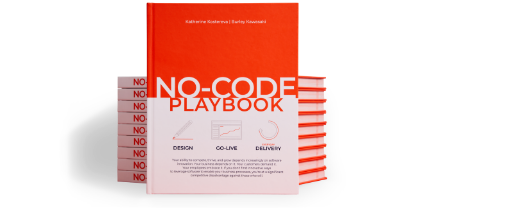Building your Center of Excellence
Establishing a No-code Center of Excellence (CoE) is an evolutionary approach in most organizations. Rarely is the CoE created and set up all at once with the initial no-code project. Instead, it’s more often a result of organic growth and expansion when project teams start to gain success and experience in using no-code across different parts of the organization. Evolutionary steps toward no-code maturity allow the organization to build the business case for broader investment based upon proven success, allowing the CoE to grow and adapt. This incremental approach to forming a No-code CoE aligns with the “Everyday Delivery” philosophy. Start small, target a focused delivery of an initial CoE capability (think “MVP”), and then collect feedback on how it is performing so that you can evolve it over time. You can expand the CoE incrementally as you continue to deliver more no-code projects. In this manner, the CoE will grow and evolve in alignment with your successful use of no-code.
We have previously outlined that the No-code CoE is a go-to option for many application scenarios. The Application Matrix allows you to define where exactly you can apply it. In addition to that, the CoE approach is invaluable to driving efficiency, effectiveness, and overall impact of your no-code development practices. It can also play a significant role in radiating the no-code culture within your organization.
This chapter dives deeper into the No-code CoE and outlines how to establish one inside your organization. We’ll look at the typical evolution of the CoE and common levels of progressive maturity. We’ll outline seven of the key capabilities to focus on when you are defining the CoE. However, as always, this should be merely a starting point and guide that you can tailor for your unique needs and requirements.
The Maturity of Your No-code CoE
While everyone’s evolution and expansion of the CoE may look slightly different, these are the stages you can typically expect to see:
Stage 1
This is the starting point for your No-code CoE journey. It often starts by establishing an initial small team of one or two individuals who may be part-time. The initial core team begins to assist the organization by defining the charter of the CoE and establishing sponsorship within the business and IT groups. The team also develops the initial definition of CoE roles and begins to implement standard processes. At this point, CoE engagement is usually opportunistic with individual no-code project teams. Each team will be engaged and addressed individually as needs arise.
Stage 2
At this stage, the No-code CoE identifies and clearly defines critical roles, and starts to formally assign full-time resources. As a result of successfully delivering a few simple apps, the CoE is able to further formalize the responsibilities of team members and define a repeatable engagement model for how the CoE should work with individual project teams. Then, the CoE establishes a lightweight guidance model and basic mechanisms for feedback collection and auditing for reuse.
Stage 3
The No-code CoE is executing on its charter and has delivered a robust set of initial projects, providing expertise to their project teams. By now, the CoE maintains an extensive library of best practices, coordinates reuse around shared components, and guides teams to develop high-quality solutions that perform well and are scalable. Delivery best practices and assets are available and used by multiple business units. Processes are in place to measure results, and business outcomes and successes are reported.
Stage 4
The No-code CoE is engaging proactively, consistently and broadly across the organization, effectively measuring results, time to value, and business outcomes. It now provides support for the full spectrum of apps ranging from simple to mission-critical solutions (and has operationalized the Application Matrix to help teams know when they need to scale). The No-code CoE expands its library of Subject Matter Expertise (SME) services and best practices. It has implemented formal processes for enabling a composable architecture, including establishing processes for identifying, curating, and reusing components, and measuring the success of reuse.
These defined maturity levels are meant as a guide to help internal stakeholders set the right expectations around the CoE and how it effectively enables and supports the organization. You want stakeholders to be excited about the vision and potential for the CoE, but they should also be realistic about where you are in the phased evolution journey.
Framework for No-code CoE
When forming your CoE, it’s helpful to begin with a framework that addresses the dimensions of People, Processes, and Technology.
People
A core part of the No-code CoE is providing the expert resources that support the rest of the organization. The CoE resources will offer a deep knowledge of the business processes, technical expertise, and no-code delivery methodology.
Processes
Building a repeatable and scalable model for no-code delivery across the organization is built around the formalization and sharing of prescriptive best practices. The CoE will play a key role in continuous learning from each project’s success, applying the most successful practices, and monitoring the industry.
Technology
Delivering transformation with no-code at scale requires a capable, reliable, and secure platform for no-code development. It must meet current needs and, importantly, be able to accommodate future demand. The CoE will play a key role in establishing and evolving the technology platform, including managing shared environments and operational know-how.
Supporting this high-level framework, your CoE should invest in a set of important capabilities that enable and support each of these dimensions:
These key CoE capability areas are briefly described in the sections below.
Capability #1 Form a strong foundational CoE team
Capability #2 Establish a lightweight, consistent governance model
Capability #3 Evolve clear process best practices and design principles
Capability #4 Continuous process improvement
Capability #5 Establish reliable, secure, and scalable technical environments
Capability #6 Curate library of internal reusable components
Capability #7 Advocate no-code as part of your digital transformation strategy
Final Takeaways
There’s a lot to think about when establishing your No-code CoE. Don’t try to do it all at once. Instead, embrace an evolutionary approach, and adopt the “Everyday Delivery” philosophy to build out your CoE. Just like developing no-code apps, your approach to building your CoE can be to deliver an MVP and then evolve rapidly based upon your learnings. Investing in your No-code CoE will take time, but it will eventually help accelerate the delivery of value, and your no-code teams will realize even greater efficiency and productivity.



